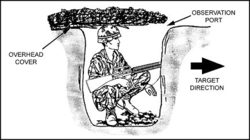Spider hole
A spider hole in military parlance is a type of camouflaged one-man foxhole, used for observation.[1] A spider hole is typically a shoulder-deep, protective, round hole, often covered by a camouflaged lid, in which a soldier can stand and fire a weapon. A spider hole differs from a typical foxhole in that a foxhole is usually deeper and designed to emphasize cover rather than concealment.

The term is usually understood to be an allusion to the camouflaged hole constructed by the trapdoor spider. According to United States Marine Corps historian Major Chuck Melson, the term originated in the American Civil War, when it meant a hastily dug foxhole. Spider holes were used during World War II by Japanese forces on many Pacific battlefields, including Leyte in the Philippines and Iwo Jima.[2] They called them "octopus pots" (たこつぼ, takotsubo) for a fancied resemblance to the pots used to catch octopuses in Japan.[3] Spider holes were also used by Vietnamese Communist fighters during the Vietnam War.
The American columnist William Safire claimed in the December 15, 2003, issue of the New York Times that the term originated in the Vietnam War.[4] According to Safire, one of the characteristics of these holes was that they held a "clay pot large enough to hold a crouching man." If the pot broke, the soldier was exposed to attack from snakes or spiders, hence the name "spider hole".
On December 13, 2003, during the Iraq War, American forces in Operation Red Dawn captured Iraqi president Saddam Hussein hiding in what was characterized as a "spider hole" outside an Ad-Dawr farmhouse (near his hometown of Tikrit).[5]
References
- Staff (April 18, 2003), "Chapter 5 Security Operations: 5-27. Types of ground observation posts.", FM 3-21.94: The Stryker Brigade Combat Team Infantry Battalion Reconnaissance Platoon, Washington D.C.: Headquarters Department of the United States Army
- Cannon, M. Hamlin. Leyte: The Return to the Philippines. U.S. Army Center of Military History, 1954., p 211
- Marston, Daniel (editor) (2005). The Pacific War Companion: From Pearl Harbor to Hiroshima. Osprey Publishing. ISBN 978-1-84603-212-7.CS1 maint: extra text: authors list (link)
- Safire, William (2003-12-15). "From the 'Spider Hole'". New York Times.
- "'We Got Him,' and Then a Call by American and Iraqi Officials for Reconciliation". New York Times. 2003-12-15.